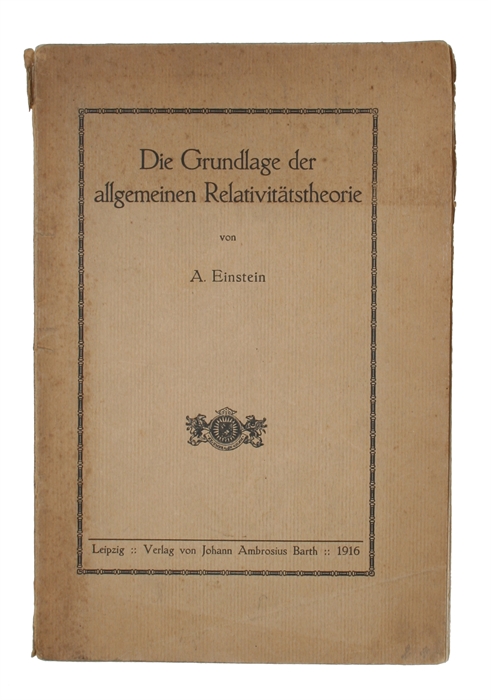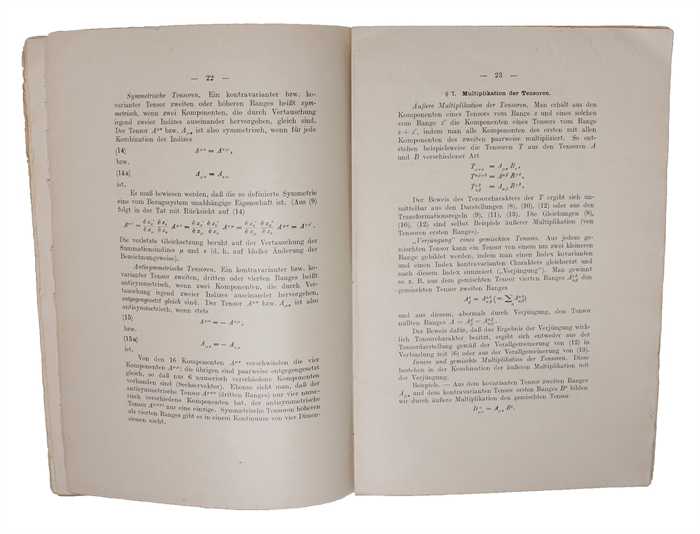TRANSFORMING THE SCIENTIFIC OUTLOOK OF THE 20TH CENTURY
EINSTEIN, ALBERT.
Die Grundlage der allgemeinen Relativitätstheorie. (The foundation of the General Theory of Relativity).
Leipzig, Ambrosius Barth, 1916.
8vo. Uncut in the original printed wrappers. Top part of spine loosening, but fully intact and completely unrestored. A bit of dusting to wrappers. Front wrapper with some mild brownspotting to upper part and left margin. Lower right corner has been bent, leaving a crease. A few nicks to extremities. Title-page with light brownspotting to upper margin and an old owner's name across the middle ("Ernst Helmut Klein"). 64 pp.
First issue of the first edition in book form, being, not an offprint of the"Annalen der Physik" journal issue as often stated, but a separate edition of the paper, completely re-set and with significant changes and additions, including for the first time in print the "Einleitung" and the "Inhalt".
The first issue is distinguished from the later reprints by the printing of "Sonderdruck aus dem "Annalen der Physik" Band 49, 1916", and "Druck von Metzger & Wittig in Leipzig. 314" to the verso of the title-page and "Metzger & Wittig, Leipzig" to the foot of the back wrapper. Furthermore, "This separate edition is printed on good, strong paper, the wrappers are of strong material too, and it is described now as 'the original edition' of this classic paper" (Weil).
Einstein's seminal "General Theory of Relativity" has had an immense impact on all science, philosophy, and man's view of the world in general. Few other books of the 20th century can be said to have so basically altered the way that we view the world and our place in it.
Determining space and time as being interwoven into a single continuum known as "space-time" and determining that there is no absolute space-time coordinate system - i.e. that there are no absolute positions in time and pace - established the fact that events that occur at the same time for one observer could occur at different times for another, i.e. all positions in space and time are relative.
This general theory of relativity, here presented in its full exposition for the first time, in book form, is now a basic foundation for scientific thought.
"The theory of relativity has transformed astrophysics, and indeed the whole scientific outlook." (PMM).
"Whereas Special Relativity had brought under one set of laws the electromagnetic world of Maxwell and Newtonian mechanics as far as they applied to bodies in uniform relative motion, The General Theory did the same thing for bodies with the accelerated relative motion epitomized in the acceleration of gravity. But first it had been necessary for Einstein to develop the true nature of gravity from his principle of equivalence...Basically, he proposed that gravity was a function of matter itself and that its effects were transmitted between contiguous portions of space-time... Where matter exists, so does energy; the greater the mass of matter involved, the greater the effect of the energy which can be transmitted. In addition, gravity affected light... exactly as it affected material particles. Thus the universe which Newton had seen, and for which he had constructed his apparently impeccable mechanical laws, was not the real universe... Einstein's paper gave not only a correct picture of the universe but also a fresh set of mechanical laws by which its details could be described" (R.W. Clark).
"This paper was the first comprehensive overview of the final version of Einstein's general theory of relativity after several expositions of preliminary versions and latest revisions of the theory in November 1915. It includes a self-contained exposition of the elements of the tensor calculus that are needed for the theory. (T. Sauer in Landmark Writings in Western Mathematics).
PMM: 408. - Horblit 26 c. - Weil 80. - Boni: 78,1 - Schilpp-Schields: 86.
Order-nr.: 48068





